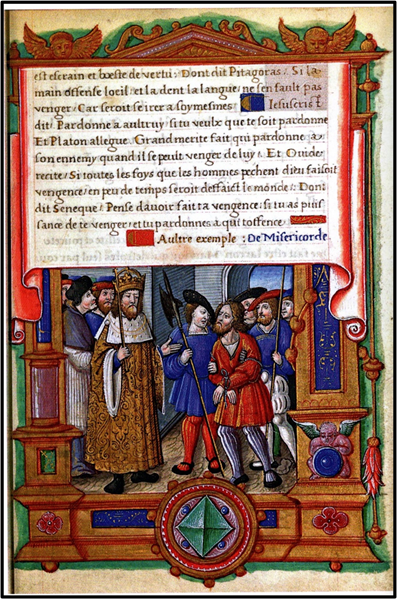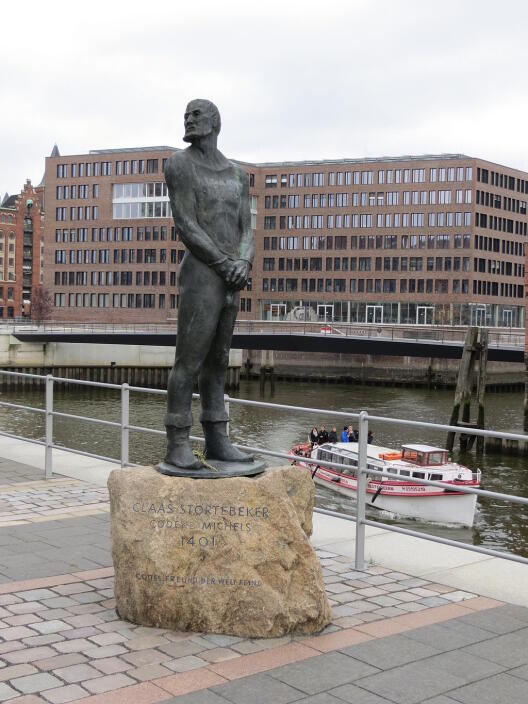“Professional service providers in the maritime violence market”
Before the "pirate" concept emerged in the late Middle Ages, violence was not per se illegitimate – Interview with Gregor Rohmann

Did pirates really exist? Certainly not as the stereotyped image that most people might have in mind when they think of the legendary Klaus Störtebeker or even Captain Jack Sparrow. Looting and violent confrontations, however, were the order of the day at sea. In certain situations, this was even legitimate and conformed to norms, says historian PD Dr. Gregor Rohmann. During his fellowship at the Käte Hamburger Kolleg, he is researching controversial semantics of the maritime capture of goods in late medieval northern Europe. He succeeds in tracing a development at the end of which stands the conceptual formation and simultaneous distinction of “pirates”. Gregor Rohmann explains in an interview what this has to do with nation building, who the real actors behind the pirates were and where the Störtebeker myth comes from.
Dr Rohmann, in your research you concentrate on the history of the Hanseatic region in the pre-modern era. Specifically, you are currently examining changing patterns of interpretation concerning the use of violence at sea, which was, for a long time, considered legitimate. Was the sea a lawless vacuum in the Middle Ages?
It’s a classic cliché that there was no law in the maritime sphere before the dawn of modernity. This may have been true for the high seas because no one was sailing there anyway. Until mechanical aids for astronomical navigation were introduced, navigation was usually based on landmarks and sea marks, on measuring the depth of the water and the nature of the seabed with a sounding lead, and, if possible, also on the sun and stars. The ships were coasting and, therefore, almost always within the sphere of influence of terrestrial authorities. Towns, landlords, sovereigns on the shore had the right (and certainly the duty) to control shipping on their doorstep. The major trade routes were regarded as a “stream ”, that is – in modern terms – as a sovereign territory for which there could of course be competing claims. Moreover, there were indeed legal customs among the seafarers and merchants for how to deal with each other. However, part of these implicit or explicit norms was that in certain situations – and only then! – the use of violence was legitimate. This does not mean that people constantly beat and robbed each other at sea with impunity, but that they faced each other armed. From the late Middle Ages onwards, this by tendency horizontal order of social coexistence was replaced by a vertical one, in short: by the “state” with its claim to a monopoly on the use of force. Whether the maritime world became more peaceful as a result remains to be clarified.
You argue for a conceptual-historical approach. How exactly do you proceed – what sources do you rely on and what do you think are the advantages and limitations of this method?
We postulate a state of legal pluralism for the Middle Ages in general and for the maritime sphere in particular. However, our problem is that, in terms of sources, unwritten norms can at best be indirectly grasped. In my opinion, the variability of norms is best reflected in the diversity of terms and their use. That’s what I would like to investigate.
Historical semantics offers a toolbox for this purpose, which allows us to formulate hypotheses that are at least reasonably verifiable methodologically. Above all, it requires radically questioning the prior knowledge of the compendiums as a first step. True, the newly assembled picture still has gaps, due to the one-sided method and the source situation. Since these blank spots are deliberately made visible, this picture is sometimes unsatisfactory at first glance compared to the old compendium findings, which tend to resolve gaps from a macro perspective. Yet the result is hopefully more source-critically correct and thus more scientifically valid.
The questions were posed by Lennart Pieper.

“The ‘pirate’ became the ‘enemy of all’ who was outside of jurisdiction”
You detect a fundamental process of reinterpretation, from a great diversity of concepts to a semantically and legally significant standardisation: in the end, the “privateer”, who is perceived as legitimate, and the “pirate”, who acts criminally, are in opposition to each other. Chronologically, you can date this process quite precisely to the years between 1370 and 1435. What is it that happened during this time?
To start with, 1370 (Peace of Stralsund) and 1435 (second Peace of Vordingborg) were only pragmatically chosen dates for the beginning and end of the period under investigation. It took longer in the North and Baltic Sea regions until the typical early modern prize law was enforced, until around 1470. However, I was particularly interested in the decades around 1400 because there was not so much talk of “pirates” and “privateers” then (the latter being a modern term anyway). There was rather a wide variety of terms that were used to describe violent maritime players and their actions. Roughly speaking: until 1370, there were hardly any generic designations for such actors apart from “zeerovere” and “soldenere”. Then, a great many emerged in a short time, and from 1435 onwards, this diversity gradually decreased again, until eventually only the ideal-typical dichotomy of supposedly “evil” and supposedly “conforming to norms” remained.
Did the semantic distinction also result in a legal ban on piracy? Is this development comparable to the proclamation of Ewiger Landfriede of 1495, a pax perpetua which prohibited the nobility from feuding?
Both bans had to be enforced first, which, as we know, took time. In the terrestrial space, a norm had been set with the Landfriede. Breaching it could become a criminal offence. Maritime law, on the other hand, was only interested in “piracy” in connection with questions of liability and compensation until well into the 16th century. No law was enacted, but a total social exclusion was discursively enforced: the “pirate” became the “enemy of all” who was outside of jurisdiction. Therefore, no prohibitions were needed for killing them – the sanction is theoretically much stronger. In practice, however, it remained at least as much subject to negotiation in the specific case as it did on land. The accusation of piracy hung over the actors like the sword of Damocles from then on. In case of doubt, however, this only affected the subalterns, those whose social bargaining base was weak for whatever reason.
Who were the actors who successfully used the pirate narrative? What were their interests?
First of all, all political and economic actors in the maritime sphere used violence to pursue their interests, either as a threat or as a practice. The sword normally remained in the scabbard because everyone had one. But because everyone had one, they were all willing to draw it. Now, you have stronger and weaker players, and the stronger ones begin to underpin their position discursively by developing the claim to set and enforce norms. By accusing my competitor of being a pirate (or of hiring and supporting them), I can legitimise my using violence against him. So the narrative, like the violence itself, serves to assert my own claims. In retrospect, we perceive these hegemonic actors as protagonists of nation building. Yet they were simply the ones who won.

“The problem was that all sides were hiring these people”
A special focus of your research is on the so-called Victual Brothers, who are known to many people through their legendary leader Klaus Störtebeker. However, much of what we think we know about Störtebeker and his pirates is ultimately based more on legends than on historical facts. Where do these myths actually come from and what makes them so successful to this day?
From around 1390 onwards, the term “Vitalienbrüder” (Victual Brothers) referred to groups of professional service providers in the violence market. This market had emerged as a result of the many wars in northern Europe since the 1360s. The problem was that (similar to the case of the onshore mercenaries) all sides hired these people, but at the same time, they feared the potential for violence that they would bring. This threat could be projected onto the imagination of a company of almost mythical outlaws, while in real life, of course, people continued to cooperate with the concrete entrepreneurs of violence.
In the so-called Wendish cities (Lübeck, Hamburg, Rostock, Wismar, etc.) around 1400, internal crises added to this, during which the councils dominated by the merchants saw it as an opportunity to turn an external threat into an enemy stereotype in order to justify the enforcement of their own interests. From 1427 onwards, Lübeck and Hamburg had to justify themselves to the king and the other Hanseatic cities for openly allowing Victual Brothers to fight for them. It was during this period that the Störtebeker legend was created, with which one could put one’s own heroic struggle three decades earlier in perspective, precisely because one did not want to talk about the current alliances.
Störtebeker lent himself to this because his name (“lidded jug”) was open to associations of Dionysian transgression in every form. Even the ancient Dionysus had been a pirate at times, and the learned chroniclers now proceeded to turn the Gdansk captain Johannes Storcebechir increasingly into a Dionysus redivivus: ruthless but just, drinking hard, a heartthrob, able to walk without his head, etc. All this comes from the ancient Dionysus myth and is still resonating today when restaurants and cafés are named after him.
As a historian, do you also see it as your task to deconstruct such myths?
Certainly! From an academic point of view, dealing with such legends is persistently reputed to be popular, that is, unscientific. But I don’t give up hope that our work could contribute to making the world at least a little bit more reasonable. Nevertheless, here’s a warning to young researchers: you don’t gain a reputation with it. For the public, you’re the killjoy, and some colleagues feel miffed because they didn’t think of it themselves.
You have already been involved in the Kolleg as a Digital Fellow since July and from November, you will also be working and researching on site in Münster for a few months. How have you experienced the digital fellowship so far and what do you hope to gain from the attendance phase?
The digital fellowship was initially only a makeshift solution, as the pandemic made on-site meetings impossible. However, it quickly became appealing in its own way to be able to talk to so many different colleagues so easily when working from home. In my impression, this also became very fruitful very quickly. Still, the personal, random exchange in everyday life is missing, so I’m very much looking forward to the attendance period. For sure, many ideas for productive cooperation will then quickly become more concrete.
The questions were posed by Lennart Pieper.

